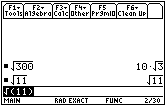
Here is one possible keying sequence.
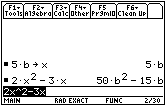
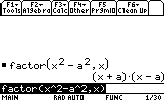
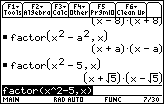
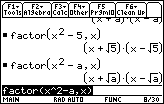
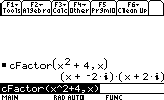
so predict that (x + 1)6 = x6 + 6x5 + 15x4 + 20x3 + 15x2 + 6x + 1
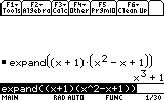
©Copyright 2007 All rights reserved. | Trademarks | Privacy Policy | Link Policy
| Module 2 - Answers |
| Lesson 1 |
| Answer 1 |
|
2.1.1
|
|
|
|
|
| Answer 2 |
|
2.1.2
The TI-89 returns the expression
|
|
|
|
|
| Answer 3 |
|
2.1.3
|
|
|
|
|
| Lesson 2 |
| Answer 1 |
|
2.2.1 50b2 – 15b
Here is one possible keying sequence.
|
|
|
|
|
| Lesson 3 |
| Answer 1 |
|
2.3.1 The factors are the sum and difference of the square roots of the two terms and have the form |
|
|
|
|
| Answer 2 |
| 2.3.2 x2 – a2 = (x – a) (x + a) |
|
|
|
|
| Answer 3 |
2.3.3

|
|
|
|
|
| Answer 4 |
|
2.3.4
|
|
|
|
|
| Answer 5 |
2.3.5

|
|
|
|
|
| Answer 6 |
|
2.3.6
|
|
|
|
|
| Answer 7 |
2.3.7

|
|
|
|
|
| Answer 8 |
| 2.3.8 Each row begins and ends with 1, and each additional entry is the sum of the two entries directly above it. For example, the second term in the fourth row, 5, is the sum of 1 and 4, the first two terms in the third row. |
|
|
|
|
| Answer 9 |
|
2.3.9 The next line in the triangle shown is 1 6 15 20 15 6 1, so predict that (x + 1)6 = x6 + 6x5 + 15x4 + 20x3 + 15x2 + 6x + 1 |
|
|
|
|
| Answer 10 |
2.3.10

|
|
|
|
|
| Self Test |
| Answer 1 |
|
|
| Answer 2 |
|
|
| Answer 3 |
| A, B |
| Answer 4 |
|
False. Even in Exact mode, a decimal approximation is found by pressing
|
| Answer 5 |
|
|
| Answer 6 |
|
The
|
| Answer 7 |
| Students are actively involved in learning instead of passively listening. They have a sense of ownership when they discover a concept. They are more interested in the proof of a theorem they have discovered. |
|
|
|
©Copyright 2007 All rights reserved. | Trademarks | Privacy Policy | Link Policy |